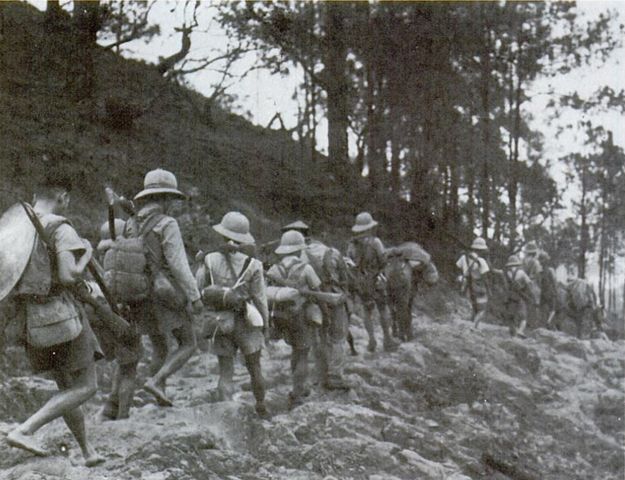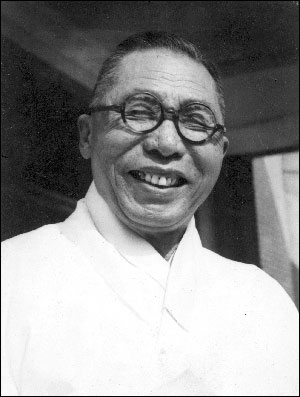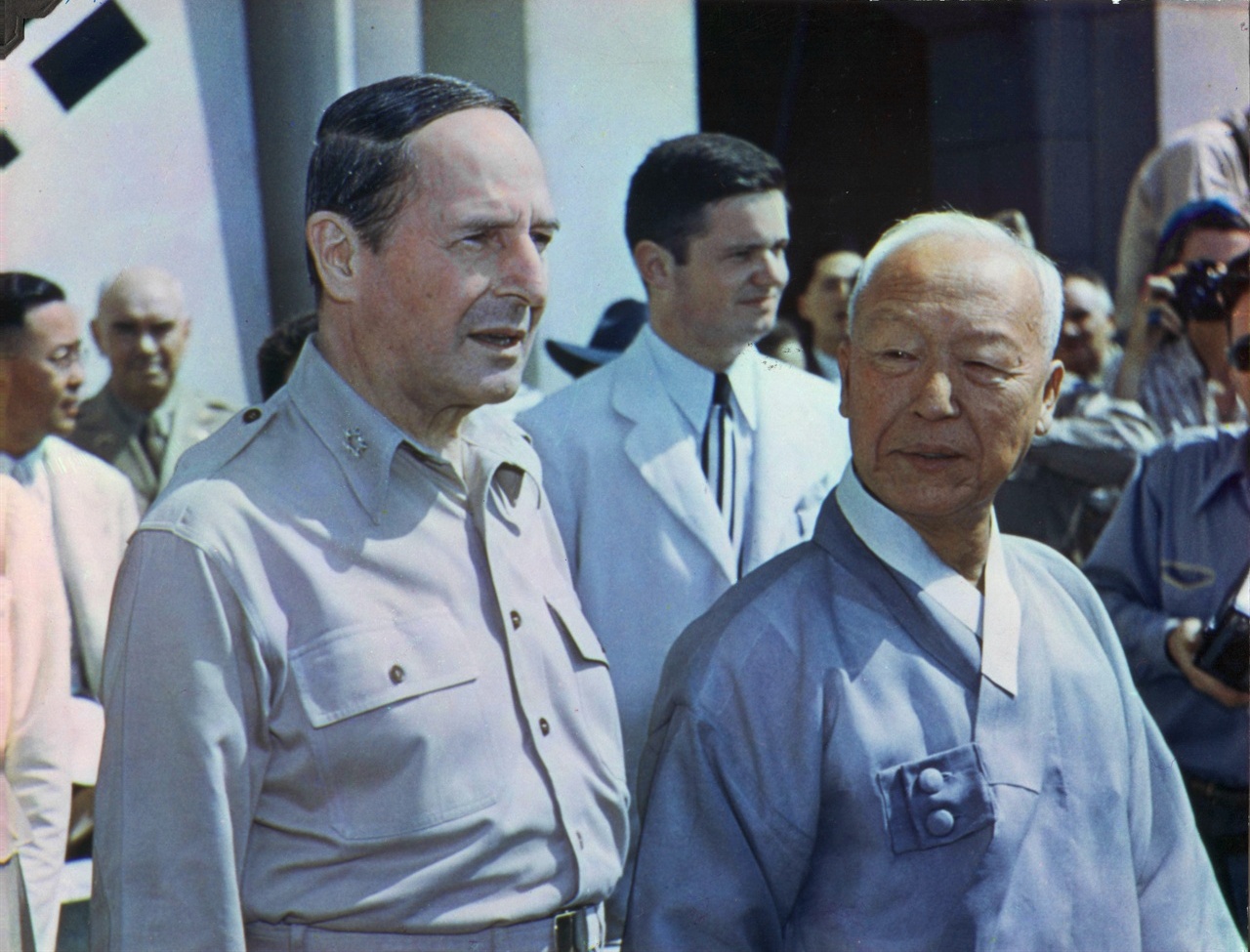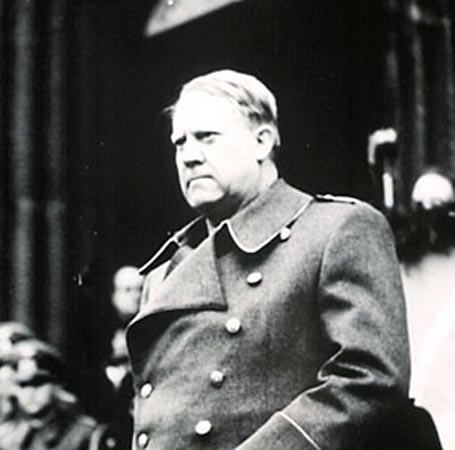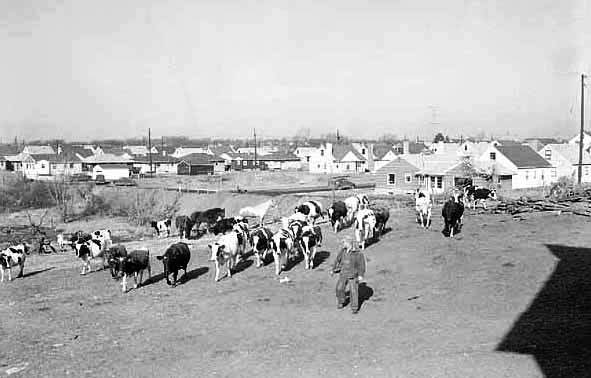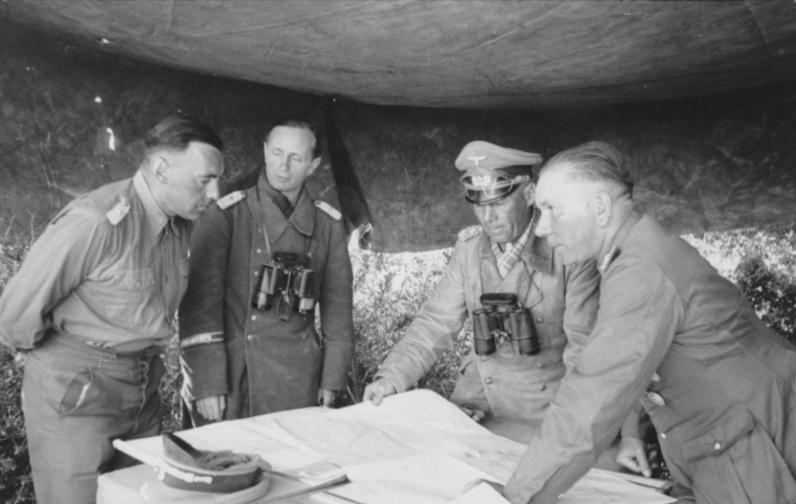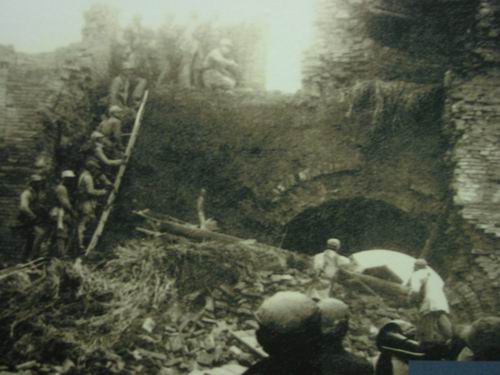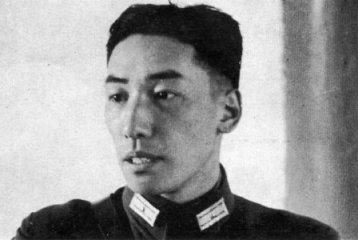1945: Latter Half
One of the many outdated German tanks being decommissioned
With victory won at long last, the worn-out Wehrmacht began to draw down to its new peace time strength. Hundreds of divisions were disbanded, and millions of men returned to their homes and families, lands they haven’t seen for years. The reduced size of the military allowed for a greater concentration of modern war machines and weapons, greatly diminishing the amount of the Wehrmacht using outdated equipment. Most infantry were now using the state of the art STG 44 assault rifle, and all armoured divisions had ample numbers of Tigers, Panthers, and the latest tank destroyers. Though the Wehrmacht had been reduced in size, its strength had greater concentration.
The death of Reichsführer-SS Heinrich Himmler had sent the SS into a struggle of epic proportions to determine his successor, with Byzantine politics threatening to tear the institution apart. Unwilling to let this anarchy continue in one of the Reich’s most important organizations, the Führer stepped in to personally direct the future of the SS. It was decided that Himmler’s dream of a state within a state was impractical and dangerous, so the SS would be divided. The Allgeimene-SS would be given control over the civilian and non-military functions of the SS, primarily adopting the duties of the RSHA, being led by Interior Minister Ernst Kaltenbrunner, the former head of the RSHA. The military units of the SS, the Waffen-SS, would be separated and formed as an independent military formation in the Wehrmacht, operating in parallel to the Heer. General Paul Hausser would lead the Waffen-SS in its new capacity.
Interior Minister Ernst Kaltenbrunner, new head of the Allgeimene-SS
The German Reich had been at war for nearly six years, and its economy had become heavily geared to support the war effort. Rationing and shortages of luxury goods had been accepted by the German people as a price to pay for the good of the Fatherland against the Bolshevik menace, but with victory achieved, they could not be expected to further accept sacrifice. The Führer and his subordinates understood this, and began a program to shift the German economy back to a peace time footing, increasing food production and creating consumer goods, though military production would not be scaled back entirely due to the large amount of the Wehrmacht that remained on active readiness. To further emphasize the return to a peace time economy, woman and foreign “laborers” were dismissed from German factories to make room for returning Wehrmacht veterans. Though production of new equipment and other military supplies took a sharp drop from this shift, the German populace was relieved to see a return to normalcy, if only partially for now. The economic disruption from the shift was also expected to only be temporary as well, with the German economy hoped to return to a growth period in early 1946.
Like its Axis ally, Italy too began to demobilize its army, removing nearly two dozen divisions from duty, and mothballing its aircraft carriers and dive bombers. Hundreds of thousands of veterans returned home, hoping to return to their jobs from the times of peace, but found a dearth of opportunities as their old jobs were now occupied by woman and others mobilized to support the economy. Thousands of dissatisfied and impoverished veterans became a common sight in major Italian cities. The government encouraged them to colonize the North African colonies to find a new life, and while some took the offer, others refused to leave their native Italia. Discontent begins to bubble from this matter, and the continued emphasis of the economy on war production.
Sotirios Gotzamanis, Prime Minister of the Hellenic State and leader of the newly formed Greek Fascist Party
In Greece, new pressure from Italy saw a reorganization of the Hellenic State. All officials in the government were required to be part of the newly formed Greek Fascist Party. The reorganized government then began to distribute food aid to the population in areas loyal to the Hellenic State, earning their thanks, but also the ire of the rest of the county.
Spain too began to demobilize its military, dismissing half of its infantry divisions, with the remaining forces split between Iberia and Morocco. The men from the discharged divisions were then directed to construct road and rail lines across Spain, to improve the national infrastructure and invigorate the national economy, and was expected to last 5 years. The dismissed former soldiers were not happy to be forced to do this demanding manual labor for many years without a choice in the matter, and progress on the development was slow for the first few months the program was in operation.
In Romania, a major agricultural initiative was launched, to sell the land gained in Transnistria, as well as captured agricultural vehicles and surplus trucks. All of these would be sold cheaply to Romanians, to encourage colonization of the newly conquered lands and boost agricultural production of the state. While this effort was partially successful, and agricultural yields increased, a substantial portion of the potential Romanian workforce remained under arms in the mobilized military, retarding the surplus workers required to full enact the colonization plan.
The amble bounty of Transnistria (as presented in Romanian propaganda)
Regent Horthy commanded that 90,000 new houses should be built in Gyula, Debrecen, Nyiregyhaza, Uzhhorod, Muncaks, Berehove and Huszt, to encourage further growth and development in eastern Hungary. Many of these would be inhabited by the veterans of three disbanded divisions, as Horthy had ordered a partial demobilization of the Hungarian army, also lowering the readiness of the army as a whole, moving Hungary closer to a peace time footing.
Agents of the Hungarian Kingdom also produced a film in the Slovakian language, for distribution in the Slovak Republic. The film depicted the Eastern Front in the First World War, with Hungarian and Slovakian soldiers fighting the Russian hordes, and finding mutual understanding and camaraderie in their hardships. The film was well received among young Slovakians, who hailed it as a great remainder of Slovakian and Hungarian friendship, but older generations viewed the film with worry, fearing that Hungary had further designs upon the already reduced territory of the Slovak Republic.
The reconstruction of the Republic of Finland as a constitutional monarchy was a controversial one. President Risto Ryti tried his utmost, calling in every political favour he was owed and putting pressure on anyone he had leverage over. Combined with his decision to have Finland join the Axis Powers, many began to call Ryti a German stooge, selling the country to the Nazis. Despite the blows to his previously high prestige and popularity, Ryti managed to barely secure the approval of Parliament to form the Kingdom of Greater Finland. Prince Philipp was crowned as King Väinö I to much fanfare, adopting the responsibilities of the President as the position was abolished. Ryti would follow this bitter triumph by entering a retirement, leaving a controversial legacy for Finland. Field Marshal Carl Gustaf Emil Mannerheim decried the establishment of the Kingdom and ascension to the Axis as a betrayal of the Finnish people, and resigned his military commission, with many officers following him in protest.

Field Marshal Mannerheim is a hero to most Finns, and a staunch opponent of subservience to Germany
Attempts by the Ukrainian Insurgent Army to expand its influence into Eastern Ukraine, Romania, Hungary, and the General government, were matched by a fierce containment effort by the Gestapo in Reichskommissariat Ukraine. Skirmishes between police units and the insurgents became common place, and the sheer size of the area to be contained meant that agents of the UPA did indeed reach new regions and lay down new operations, though in much lower numbers than they had hoped. Harsh efforts by the German police units to crack down on UPA supporters were met by equally savage attacks by the UPA against collaborators. Local Ukrainians were increasingly driven to support whatever power was more prominent in their local area. Though the war in the east had been declared at an end, the Ukraine was increasingly resembling a war zone, and the countryside was declared unsafe for unarmed travel. Partisan activities in other parts of the former Soviet Union remained active, but none to the extent of the Ukraine. The UPRA remained relatively quiet in its base of support in eastern Ukraine, possibly building up strength while its rivals battered against each other.
In Reichskommissariat Norwegen compulsory membership in Nasjonal Samlings Ungdomsfylking was enforced for all youths aged 10 through 18. All other youth groups were to be disbanded for insufficient devotion to the Nordic ideal and patriotism. The young boys and girls in the NSU were to participate in fun outdoor activities, extracurricular educational correction, and formal parades appreciating the militaristic heritage of Norway. Very few complaints were officially lodged, and by the end of the year the program was being well enforced, to universally positive feedback from the children involved.
Vidkun Quisling, de jure leader of Norway, and architect of the Nasjonal Samlings Ungdomsfylking
Fearing internal instability being used to tear his nation apart, King Peter II of Yugoslavia relinquished his power over the appointment of Yugoslavia’s upper house as part of a governmental reform plan. Instead the upper house would consist of 36 members, 4 elected from each of the 9 provinces by way of Single Transferable Vote. The lower chamber would continue to use alternative vote however. Free elections were promised to occur a year after the reforms took place, in late 1946. All parties were allowed to participate freely, excepting communists and the Ustaša. Though the banning of the former attracted very little ire, the banning of the latter inflamed Croatian nationalists, and several officials administrating regions of Croatia were attacked following the announcement of the reforms. Most of the rest of the nation perceived the reforms as an important step in the right direction.
Possibly in response to the increased activities of the Ustaša, greater funding was given to internal police and security agencies to crack down on anti-government, particularly separatist, activities. Several Ustaša members were arrested late in the year following this increased focus and funding.
The Sudan became the focus of the Egyptian government following the victory in Russia, with new batches of bureaucrats embarking to replace the long removed British administrators in the region. Sudanese independence movements had been gradually gaining strength and the Egyptians hoped to keep a lid of them through closer ties to Egypt’s government. Some Sudanese were also allowed positions in the lowest rungs of the Egyptian bureaucracy if they were Muslims, could speak Arabic, and had no connections to any independence movements. Egyptian control over the Sudan was indeed further entrenched, but the feelings of the Sudanese population at large remained unclear.
The Arab Higher Committee authorized the creation of a new organization, the Fedayeen Arabiya. A paramilitary organization based on the (now divided) SS and led by Hasan Salama, the Fedayeen Arabiya was tasked with eliminating threats to the Arab people, at this point principally Jewish terrorist groups. Given a free hand to accomplish this goal, with no laws or regulations to guide them, the FA tore through Jewish communities in Palestine, “appropriating” valuables from potential terrorists, and executing many suspected terrorists as well. These methods appear to have little impact on the actual organizations however, as attacks increase, particularly those targeting FA members and their families. The only actual accomplishment that can be claimed so far is that Hasan and his top men are substantially wealthier. Requests for German specialists to advise the group have so far gone unanswered from Berlin.
Hasan Salama, leader of the FA, on horseback to root out Zionist terrorists
The Grand Mufti was more personally concerned with the hosting of the Second World Muslim Congress. Accompanied by prominent Muslim theologians and leaders from across the Islamic world, though notably excepting Saudi Arabia, the Grand Mufti emphasized the need for Islamic unity in the face of the Zionist threat. This secured mild support from his guests, and his suggestion that more World Muslim Congresses be held in the future was well received.
Oil production was one of the top priorities of the Iranian Imperial State, and to ensure the flow of oil was high and profitable, the Iranian National Oil Company was created, to replace the defunct Anglo-Persian Oil Company. The size of oil fields and workers assigned to operate them increased due to government pressure and funding, but attempts to have Iranians learn the finer points of well drilling from Romanians went nowhere, as the Romanians were uninterested in increasing the productivity of a competitor without government orders.
Iranian efforts to build up the strength of the Kingdom of Yemen through the shipment of arms and capital were mildly successful. Long had Yemen remained a backwards and semi-feudal state, so these efforts to improve its status were well appreciated. However the predominantly Zaydi Arab population was rather disturbed by Shia Iranian attempts to insist on the shared religious beliefs of the two nations.
As common throughout much of the world, the British armed forces demobilized in the latter half of 1945. Most of its divisions and squadrons were disbanded, those that remained reduced in strength as well. The readiness of the ships of the Royal Navy was reduced as well. The many troops returning home were guaranteed work through Labour exchange, with preference being given to those with experience in mining, farming, and construction.
There was much the Atlee government required workers for, so it was no difficulty to find work for the veterans. The National Reconstruction and Repair Authority was created, to remove the last remnants of damage from the German bombings, and to create employment opportunities for returning soldiers. Though much of the work to remove debris had long been completed, the ongoing war in the Pacific had prevented a full restoration of London and other cities hit by the Blitz, which soon became the primary goal of the NRRA. London was a good ways to resembling its pre-war self by the end of 1945.
Memories of the German Blitz are still harsh for many British citizens
The French holdings in the Caribbean had remained loyal to the French State during the Second World War and the period since, but recently discontent began to grow in these colonies. Small protests break out against the continued German occupation of France, and of the subservience of the colonies to a distant power with an ideology such as the Nazis. These protests are unprecedented and local French officials blame Anglo-American agent provocateurs. The protests were handled without much incident, but there is concern about the danger of worse events in the future.
The adoption of the new Japanese Constitution went without much resistance, if only because the ongoing American occupation left little doubt how much of a choice the Japanese really had. All political prisoners were to be released, and free elections for the House of Representatives held in October of 1945. All laws restricting political involvement were repealed as well. The three main parties to be involved in the election would be the right wing Liberal Party under Hatoyama Ichirō, the moderate Japan Progressive Party led by Machida Chūji, and the leftist Japanese Socialist Party headed by Katayama Tetsu. It was expected that the Liberals and Progressives would take most of the seats, due to the generally right-leaning nature of the Japanese people.
However most observers would be surprised when the votes returned with the JSP leading as the largest party. Many Japanese felt that the right had erred to ally Japan with Germany, seeing the Germans as an unreliable ally, in contrast to Japan’s more traditional ally of Great Britain. The recent major victory of the British Labour party had emboldened the JSP, driving them on a campaign to place the blame for Japan’s defeat on the decision to ally with Germany. This message resonated with many Japanese, and the JSP secured a sizeable plurality. Combined with the Japan Cooperative Party and the Japanese Communist Party, who had won more seats than expected by emphasizing the nature of communism as the greatest enemy of Germany, a coalition government was formed and Katayama Tetsu was sworn in as Prime Minister.
JSP- 174
Liberal- 98
Progressive- 80
Cooperative- 42
JCP- 18
Independent- 52
Japanese working in the interim government with American occupation authorities decided that a new international image of Japan was needed after the devastating war. Many would agree with this notion, and so a campaign to change American opinion of Japan was considered a good idea initially. Unfortunately the officials in charge of the program decided that the new image the Japanese needed was one of “subservient monkey servants”. While this was a popular depiction in the United States, and it quickly caught on to compare bad servants and zoo animals to the Japanese, a major scandal occurred when the Japanese public discovered what kind of image was being projected abroad. Due to most of the interim government being right leaning, this scandal tarnished their reputation as a whole and contributed to their defeat in the election.
The Communist Party of Malaysia was active following the Japanese surrender. Granaries occupied previously by the Japanese, and now by the British, were robbed and their contents distributed to the starving population. Token efforts by the British to restore taxation policy to Malaya was met by the CPM murdering the taxmen, and distributing their own money to the local populace. Public support for the CPM was rapidly growing, and they seemed to have surprisingly large quantities of capital and weaponry. A serious threat to British rule in Malaya was emerging.
Reports from the Soviet Union are as obscured as always, due to the tight control of the NKVD over outgoing reports. However what does make it out suggests that a new round of purges are being undertaken by Beria, ensuring that no potential rivals remain to oppose him.
Purges have been common in the Soviet Union for the past decade, those still within the state have come to accept this as normal
As common around the world, the United States began its own demobilization. Unlike other nations, the US was primarily concerned with removing ships from active duty. Hundreds of warships were decommissioned, thousands of planes grounded, and dozens of divisions disbanded, with millions of men freed to return home. Notably this demobilization does not stop the United States from still possessing the largest air force and navy in the world. Further, the units removed, particularly in the navy, were older and outdated models. The remaining ships and planes of the United States Armed Forces were the most modern and state of the art vessels they had available.
The millions of veterans returning home were not forgotten by the government. As the shift to a peace time and deregulated economy began, the Housing Act of 1945 was passed and signed into law by President Truman. Rent control was sustained, though exemptions were made for newly constructed buildings, and encouragement was given to support rural homeowners. Many low income buildings were produced as a result of this, employing many returning veterans in a sudden construction boom. “A home for every American family” soon became a rallying cry to a nation freed from war, and suburbs in the outlying areas of major cities quickly sprung up.
Some of the new houses constructed following the passage of the Housing Act
The US congress also passed the Bynes Plan, which earmarked $30 billion to assist the British in rebuilding their economy. The loan would be paid in four payments of $7.5 billion, to be given once a year for the next four years. Interest on the loans wouldn’t begin until 1950. The Bynes plan would go a fair way to assist the British efforts to rebuild and reconstruct their nation, as a partner to America. American companies would play a significant role in the reconstruction effort as well.
De Gaulle’s Free France recognized the need for greater cooperation with the native African peoples, and thus made efforts to more greatly integrate them into the ruling administration. City and town council elections in Equatorial Africa were opened to educated Blacks as part of this plan. Though most Africans were still ineligible to vote or have any impact on the elections, this was seen as an important first step, and many of those who did gain the right to vote became mollified, hoping that loyalty would bring them further concessions.
With the Free French standing as the last “state” in conflict with the Axis powers, a plan had been concocted by OKW to bring an end to their resistance in Central Africa. A new Afrika Korps would be formed under General Nehring, comprising many veterans from the previous North African campaign. This force would then assist the advance of Vichy French and Egyptian forces to occupy and subjugate the Free French. Nehring’s force arrived in Niger without incident, only to discover that the Egyptian advance had been canceled in favour of attempting to secure the Sudan, and that the French State had given no orders to its forces to advance against the Free French. Since Nehring had been directed to purely support an advance against the Free French, he decided he would not pursue an offensive that only consisted of his own forces.
General Nehring was an experience veteran of combat in Africa, having served under Field Marshal Rommel during the campaign in North Africa
Nehring would be quite surprised then to discover that the Free French had elected to take the fight to him instead. Several French divisions under General Leclerc invaded Niger, hoping to take the Axis by surprise and secure potential staging areas. Few Vichy forces were in the area, and those that were declined to engage fellow Frenchmen without direct orders to do so. Nehring was thus left alone to repel the last charge of Leclerc. He quickly figured out that Leclerc planned to secure Agadez, which would be vital to securing supplies and communications for any operation against Equatorial Africa. Nehring deployed his infantry divisions to dig in around the city and its main supply route. For his part, Leclerc tried to cut off Agadez, but found his troops not up to the task of dislodging the Afrika Korps, particularly when their armoured division counter attacked against any attempts on the supply line.
Repulsed from the supply line, Leclerc tried to attack the city itself, which was comparatively weakly held, due to the need to defend a lengthy supply line. The French soldiers had numbers on their side, but the Germans were better equipped, more experienced, and well entrenched. Thousands of French troops died trying to break their lines before Leclerc ordered a retreat, assuming that Vichy reinforcements were sure to arrive soon. Nehring elected not to pursue, falling back on his orders to simply support a Vichy advance, not start his own. By the end of the year, Leclerc still held much of eastern Niger, but there was little of value there, and his ability to resist a serious attack by German and Vichy forces was limited.
The French State was not only beset by issues in Africa. Though Pierre Laval had signed the Treaty of Compiègne, it had not been presented before the National Assembly for ratification. Thus the French State was left in quite a predicament when its fellow Axis members occupied and took over lands that the French State had not formally relinquished. The German occupation of northern France did not come to an end, and as such the expansion of Reichskommissariat Belgien-Nordfrankreich was undertaken without issue. However efforts by the Italians in Nice, Savoy, Corsica, and Tunisia, as well as the Spanish in Morocco, faced token French forces, who were confused as to how they should proceed. They had received no commands, yet knew the Treaty had been signed by Prime Minister Laval and that to fight the Italians and Spanish would be harmful to France. Reluctantly, the French forces withdrew without a fight, though some were disarmed by the Italians for not withdrawing ahead of time.
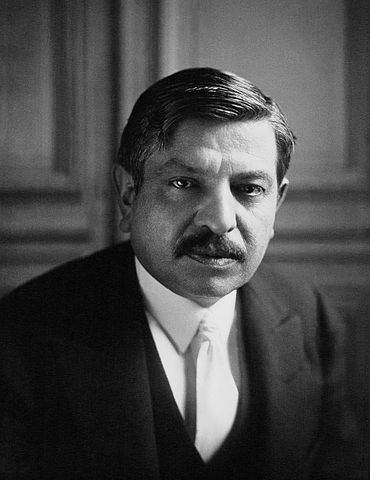
Prime Minister Pierre Laval, the man most blamed for the mishandling of the Treaty of Compiègne
French citizens were outraged. The treaty alone was bad enough, but for it to be enforced even without ratification by the French Assembly left no possible doubt to France’s status vis-à-vis Germany. French soldiers dismissed from their positions by their supposed allies without the approval of their own government brought great shame to France. In French Africa especially resentment rose, both in Frenchmen and in colonials, the former for the perceived betrayal of their nation, and the latter for the government’s disregard for the wellbeing of its colonies. It is suspected that agents of Free France are responsible for much of the negative reaction to the treaty.
[China war update incoming, stats to follow]









